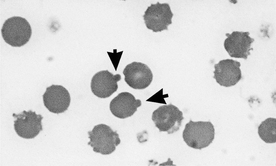2 ERYTHROCYTE MORPHOLOGY
2 What are Heinz bodies, and what causes them?
Heinz bodies are precipitates of denatured hemoglobin attached to the erythrocyte membrane. These bodies occur following oxidation of hemoglobin. Heinz bodies are found in low numbers in health in certain species (e.g., cat) or may be associated with hemolytic anemias (Figure 2-1).
7 What are spherocytes?
Spherocytes are small, spherical erythrocytes that lack central pallor. Spherocytes are more easily observed in the dog; dogs normally have erythrocytes that are slightly larger than other domestic animals, and dog erythrocytes have well-defined central pallor. Rare spherocytes may be seen in circulation before being removed by the liver or spleen, since immunoglobulin G (IgG) increases on the surface of “old” erythrocytes. This is the process by which old erythrocytes are removed from circulation (see Figure 1-2).
12 What are leptocytes, and with what conditions are they associated?
Leptocytes are thin erythrocytes with an increased amount of cell membrane relative to the total cell volume; thus they are folded over. Because polychromatophilic erythrocytes are often larger with more membrane, many leptocytes may be observed during increased erythrocyte turnover. Leptocytes also may be present with liver diseases such as portosystemic shunts in the dog. Target cells are a type of leptocyte (see Question 13).
Stay updated, free articles. Join our Telegram channel

Full access? Get Clinical Tree



